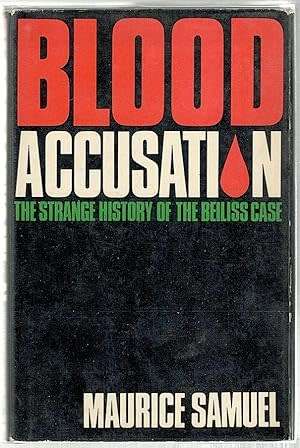
SAMUEL, Maurice - Blood Accussation : The Strange Story of the Beiliss Case - (Hardcover in Jacket)
Check my rate
View locations
| Main centres: | 1-3 business days |
| Regional areas: | 3-4 business days |
| Remote areas: | 3-5 business days |

| Main centres: | 1-3 business days |
| Regional areas: | 3-4 business days |
| Remote areas: | 3-5 business days |
Book and wrapper remained good even though it belonged to a library before - There is however a rather strange red stain at the top of the closed pages - (Methinks it looks like blood from the terrible tale written about in this book) - First British edition - 1967 - 286 pg. - Dust jacket complete and unclipped (42s net) - Original cloth boards with bright gilt titling on spine. >>> On a Sunday morning in 1911 the viciously mutilated body of a young boy was found in a cave on the outskirts of the city of Kiev, Russia. Four months later a Jewish workman, Mendel Beiliss, was arrested and charged with having murdered the boy in order to use his blood to make matzos for Passover. Thus began one of the most bizarre and extraordinary frame-ups in modern history. The officials in charge of the case were perfectly aware that Beiliss was innocent, and most of them knew who the actual murderers were. In their conspiracy they had the assistance of the Minister of Justice, the moral support of Tsar Nicholas II, the political support of the reactionaries, and the co-operation of a criminal gang led by an impudent and homicidal underworld bawd. The purpose was to give legal sanction to the ancient libel of ritual murder and to create a climate for a new program that would destroy the rising liberal dissident spirit in Russia. On the other hand a significant segment of the Russian people opposed the conspiracy. In this chronicle Mr Samuel has dramatically and suspenseful reconstructed the state's careful piecing together of the clumsy, trumped-up evidence. In the process, he brings on to the stage a fascinating gallery of participants - grotesque underworld types; government ministers, prosecutors, and their aides; detectives, informers, agents and counter-agents; the lawyers for the defense, and Czar Nicholas himself. Through extensive quotations from newspaper accounts and editorials, letters and pamphlets of the time, he has also succeeded in showing the wide-reaching effects of this infamous trial that the world followed with horror and disbelief. In an epilogue the author traces the connection of the anti-Semitic manifestations in Russia today with those of tsarist times.